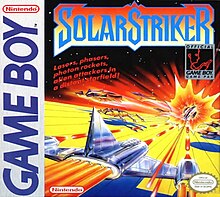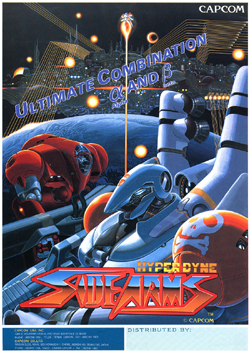
Hyper Dyne Side Arms (サイドアーム) is a horizontally scrolling shooter developed and released by Capcom as an arcade video game in 1986. The player takes control of a flying mecha fighter who must battle an alien army. Side Arms uses a two-directional attacking system similar to Capcom's previous shoot-'em-up Section Z.

Steel Empire is a horizontally scrolling shooter released on the Sega Genesis in 1992. Versions for the Game Boy Advance and Nintendo 3DS were released in 2004 and 2014, respectively. The game is scheduled for release on the Nintendo Switch in 2023.

Abadox: The Deadly Inner War is a video game for the Nintendo Entertainment System published in Japan in 1989 by Natsume and North America in 1990 by the Milton Bradley Company. It is a horizontally scrolling shooter in the vein of Gradius and R-Type taking place inside the intestinal tract of a giant alien organism. Abadox has a high difficulty, and it takes one hit from an enemy projectile to be killed and restart from a checkpoint passed before death.
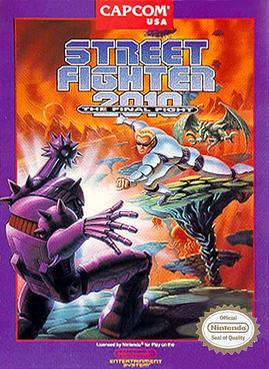
Street Fighter 2010: The Final Fight is a side-scrolling action platform game developed and published by Capcom for the Nintendo Entertainment System in 1990. It was marketed as a science-fiction-themed spin-off to the 1987 arcade game Street Fighter. Its English localization changed the name and backstory of the main character to imply that he is Ken from Street Fighter, whereas the protagonist in the original Japanese version is a completely unrelated character named Kevin. Street Fighter 2010 is a different genre from the traditional Street Fighter games, which are one-on-one fighting games.

To the Earth is a light gun shooter video game developed by Cirque Verte and published by Nintendo for the Nintendo Entertainment System. It was released in November 1989 in North America and in Europe on February 23, 1990. It uses the NES Zapper to destroy ships and gain power-ups. The enemy spacecraft require good reflexes and aiming.

Captain America and the Avengers is a beat 'em up arcade game developed and released by Data East in 1991. It features the Avengers team of Marvel Comics characters in a side-scrolling brawling and shooting adventure to defeat the evil Red Skull. The game received ports for the Sega Genesis/Mega Drive, Super Nintendo Entertainment System, Game Boy and Game Gear. A different Data East game was released for the Nintendo Entertainment System.

Earth Defense Force is a 1991 horizontal scrolling shooter video game developed and published by Jaleco. Originally an arcade game, the game was later released for the Super Nintendo Entertainment System as Super Earth Defense Force, dropping the two-player cooperative gaming mode while adding graphics and selectable weapons. The SNES version was released in Japan on October 25, 1991, and in North America in January 1992. The SNES version was eventually released on the Wii Virtual Console in Europe on October 29, 2010, in Japan on January 11, 2011, and in North America on July 14, 2011. It is included in Nintendo Switch SNES Online as of September 5, 2019.
Gradius is a series of shooter video games, introduced in 1985, developed and published by Konami for a variety of portable, console and arcade platforms. In many games in the series, the player controls a ship known as the Vic Viper.
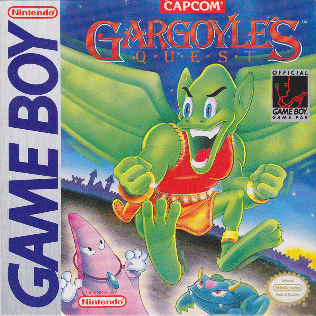
Gargoyle's Quest is an action-adventure platform game developed by Capcom for the Game Boy and released in 1990. It is a spin-off of the Ghosts 'n Goblins series, featuring the series antagonist character Firebrand as the main playable character. Gargoyle's Quest was followed by the NES prequel Gargoyle's Quest II in 1992 and the Super NES sequel Demon's Crest in 1994.
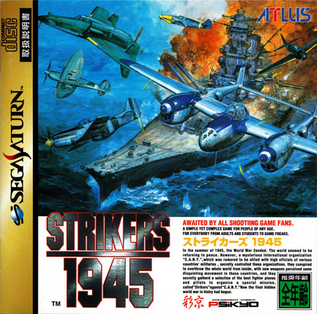
Strikers 1945 (ストライカーズ1945), also known as Striker 1945, is a vertically scrolling shoot 'em up arcade game developed and published by Psikyo in 1995. In Japan, it was ported to the PlayStation and Sega Saturn by Atlus in 1996; later was also released as part of Psikyo Shooting Collection Vol. 1: Strikers 1945 I & II by Taito for the PlayStation 2. The game was followed by Strikers 1945 II in 1997, and Strikers 1945 III in 1999, as well as the second title remake called Strikers 1945 Plus.

Thunder Force IV, known in North America as Lightening Force: Quest for the Darkstar, is a shoot 'em up video game developed and published by Technosoft for the Mega Drive in 1992. It is the fourth installment in Technosoft's Thunder Force series, and the third and final one created for the Mega Drive. It was developed by the team at Technosoft that ported Devil's Crush to the Mega Drive rather than the team that developed the previous Thunder Force games. Like its predecessors, it is a horizontally scrolling shooter, but it also features extensive vertical scrolling with large playing fields.

D-Force is a 1991 vertical scrolling shooter video game developed and published in Japan by Asmik for the Super Famicom and later localized and published in North America by Asmik Corporation of America for the Super NES. It involves an Apache helicopter set on defeating an evil Middle Eastern dictator. There are seven levels which feature six countries. Some of the levels involve switching altitudes in order to attack enemies from a different height, which uses Mode 7, one of the main features of the Super NES.
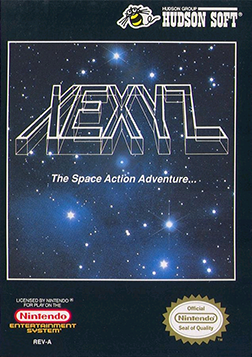
Xexyz, known in Japan as Kame no Ongaeshi - Urashima Densetsu, is a 1988 video game published by Hudson Soft for the Nintendo Entertainment System. The game was released in Japan on August 26, 1988, and saw a North American release sometime in April 1990. The game was never released in Europe and the game is not playable on PAL consoles.

Aerostar (エアロスター) is a 1991 shoot'em-up video game developed by Sigma Pro-Tech and published by Vic Tokai in 1991 for the Nintendo Game Boy.
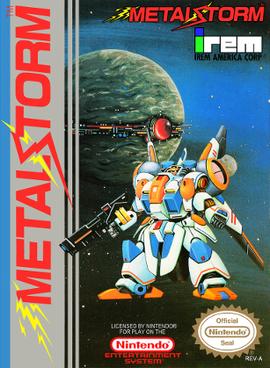
Metal Storm is an action-platform video game developed by Tamtex and published by Irem for the Nintendo Entertainment System.

Burai Fighter is a shoot 'em up video game developed by KID for the Nintendo Entertainment System. The game was released in North America by Taxan in March 1990, Europe by Nintendo and Australia by Mattel in 1990, and Japan by Taito on July 20, 1990. The game was also ported to the Game Boy and retitled as Burai Fighter Deluxe, and was released in Japan on June 27, 1990, in North America in January 1991 and in Europe in 1991; this port eventually wound up on the Game Boy Color as Space Marauder, originally released in Japan as Burai Fighter Color, as the original Game Boy version is not compatible with the later models.

Zed Blade is a horizontally scrolling shooter arcade video game developed by NMK and originally published by SNK on September 13, 1994. It is the only game created by NMK for the Neo Geo arcade platform. In a science fiction setting, players choose one of three characters to attempt to overthrow an army of enemies led by the on-board supercomputer at the automated Yggdrasil space station and seize full control of it once again.

Firestriker is an overhead view action video game that was released on December 17, 1993 in Japan and on October 1994 in North America for the Super Nintendo Entertainment System.

Chikyū Kaihō Gun ZAS is a vertical scrolling shooter video game developed and published by T&E Soft for the Nintendo Game Boy exclusively in Japan on December 18, 1992.

Tweety's High-Flying Adventure is a 2000 Game Boy Color game developed and published by Kemco, and is a platform game based on the 2000 Looney Tunes film of the same name.
